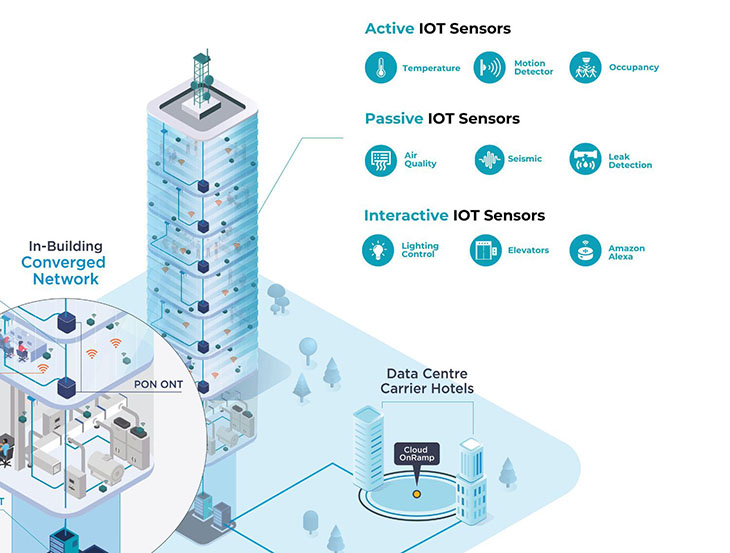The Internet of Things (IoT), a network of interconnected devices that communicate, collect and exchange data seamlessly, has revolutionized various industries including commercial property management. This article aims to provide a detailed overview of IoT’s evolution and the potential financial benefits it offers for property owners. We will focus on three primary categories of IoT sensors: active, passive, and interactive, and discuss how they can optimize building performance, reduce operational costs, and enhance tenant satisfaction.
History and Evolution of the Internet of Things (IoT)
The term “Internet of Things” was coined by Kevin Ashton in 1999 while working for Procter & Gamble. Since then, the technology has undergone significant advancements to become a vital tool for commercial property management. IoT devices and sensors can now monitor a wide range of parameters such as energy consumption, lighting levels, air quality, occupancy, and maintenance needs in real-time, providing actionable insights for decision-making.
IoT has revolutionized commercial property management by providing building owners with innovative tools to optimize energy efficiency, enhance tenant satisfaction, and reduce operational costs. IoT sensors come in three primary categories: active, passive, and interactive. Active sensors directly measure parameters such as temperature and occupancy, while passive sensors analyze ambient signals for insights on building performance and tenant behavior. Interactive sensors enable two-way communication between devices, allowing users to control their environment via mobile interfaces.
Benefits of IoT on Commercial Property Owners
- Energy Efficiency and Cost Savings: IoT sensors can detect and analyze energy usage patterns throughout a building. By implementing automated control systems that respond to occupancy, temperature, and lighting preferences, property owners can significantly reduce energy consumption and save on utility bills. For instance, smart HVAC systems can adjust the temperature based on real-time occupancy data, ensuring that rooms are only heated or cooled when needed.
- Predictive Maintenance: IoT sensors can monitor equipment health, detect anomalies, and predict potential failures before they occur. This proactive approach to maintenance reduces downtime, extends the lifespan of equipment, and minimizes repair costs. Property owners can benefit from real-time alerts, allowing them to address issues promptly and efficiently.
- Tenant Satisfaction: IoT technology enables property managers to create a comfortable and personalized environment for tenants. By offering smart control systems that allow occupants to adjust lighting, temperature, and other preferences via mobile devices, property owners can enhance tenant satisfaction and retention rates. Additionally, by leveraging data gathered from IoT sensors, managers can identify patterns in tenant behavior and preferences, leading to more targeted and effective marketing strategies.
Classification of IoT Sensors
To choose the right IoT sensors, property owners should consider factors like purpose, compatibility, cost-efficiency, scalability, ease of installation, and data accuracy. By aligning these guiding principles with their specific goals and requirements, building owners can make informed decisions that maximize the benefits of IoT technology in managing their properties effectively. An implementation plan should include defining objectives, assessing existing infrastructure, developing a timeline, selecting vendors, installing sensors, training staff and tenants, monitoring performance, and continuously evaluating and innovating to stay ahead in an ever-evolving market.
The categorization of IoT sensors by Andorix is primarily driven by the methodology employed for data collection, the level of interaction required between the sensor and its environment, and the intended application or purpose of the gathered information. The three main categories – active, passive, and interactive sensors – serve as general groupings that help simplify the vast array of IoT solutions available in the market today.
- Active Sensors: These sensors are designed to actively collect data through direct measurements or interactions with their environment. This category includes devices such as temperature sensors, motion detectors, and occupancy sensors, which are specifically designed to monitor critical building parameters like energy usage, air quality, and lighting levels. Active sensors offer real-time insights that enable property owners to optimize building performance and identify areas for improvement.
The selection of active sensors typically depends on the specific goals of the property owner, such as energy efficiency or occupant comfort. These sensors provide detailed information about various aspects of a building's operation, allowing managers to make informed decisions about resource allocation and maintenance schedules. However, they may require additional hardware installation and ongoing maintenance, which can impact cost considerations. - Passive Sensors: Unlike active sensors, passive sensors do not interact directly with their environment. Instead, they analyze ambient signals or patterns in existing data streams to gather information. An example of this type of sensor is a Wi-Fi signal strength sensor that determines occupancy levels without requiring additional hardware.
Passive sensors offer several advantages overactive sensors, including lower upfront costs and reduced maintenance requirements due to their non-intrusive nature. They can provide valuable insights into building performance and tenant behavior while maintaining privacy concerns. Property owners should consider selecting passive sensors if cost efficiency is a priority or if they wish to minimize disruption during installation. - Interactive Sensors: Interactive sensors enable two-way communication between devices, allowing users to control or interact with their environment via mobile devices or other interfaces. Examples of such sensors include smart thermostats, lighting controls, and access control systems. These sensors enhance occupant comfort and satisfaction by providing personalized control over temperature, lighting, and security settings.
The choice of interactive sensors depends on the desired level of tenant engagement and the potential for cost savings through energy management. By offering tenants the ability to customize their environment, property owners can improve retention rates and enhance the building's overall appeal. However, these sensors may require more extensive integration with existing systems and increased maintenance compared to passive sensors.

Choosing the Right IoT Sensors for your Use Cases
To effectively choose between different sensor types, a building owner should consider several factors that align with their specific goals and requirements. The guiding principles for selecting sensors can be broken down into three primary areas: purpose, compatibility, and cost-efficiency. Here’s an in-depth analysis of these factors to help property owners make informed decisions:
Purpose
Determine the objective behind installing IoT sensors in a building. For example, if the primary goal is energy efficiency, active sensors such as temperature or occupancy sensors might be the best choice. If data accuracy and privacy are a concern, passive sensors might be more suitable due to their non-intrusive nature. Understanding the specific needs of the property will help narrow down the selection process.
Compatibility
Ensure that the chosen sensors can integrate seamlessly with existing building systems and software platforms. This includes assessing whether the sensors are compatible with specific communication protocols (e.g., Bluetooth, Wi-Fi, Zigbee) and if they can easily connect to a centralized management system for efficient data analysis and visualization.
Cost-efficiency
Evaluate the cost implications of each sensor type, including hardware costs, installation fees, maintenance requirements, and potential returns on investment (ROI). Passive sensors tend to be more cost-effective upfront as they don’t require additional hardware or infrastructure. However, active and interactive sensors may offer higher ROIs in the long run due to their ability to provide more detailed data and enable advanced control features that can lead to significant energy savings and improved tenant satisfaction.
Scalability
Consider the future growth and expansion plans of the building when selecting sensors. Choose a sensor type that can accommodate potential changes in the property’s size, layout, or operational needs without requiring significant upgrades or replacements. A scalable solution will ensure that the investment made in IoT technology remains relevant and effective over time.
Ease of installation and maintenance
Assess the complexity of installing and maintaining each sensor type within the building’s infrastructure. Active sensors, for instance, may require additional wiring or setup procedures, while passive sensors can often be integrated with existing systems without significant disruption. Easy-to-install and low-maintenance sensors will help minimize downtime and reduce operational costs.
Data accuracy and reliability
Evaluate the performance and reliability of different sensor types based on their accuracy in measuring critical parameters such as temperature, humidity, or occupancy. Higher accuracy levels can lead to better decision-making and more significant cost savings for property owners.
Contact Andorix for a Comprehensive Approach to Managing your Portfolio-Wide IoT Implementation
At Andorix, we’re passionate about transforming commercial property management with cutting-edge IoT solutions tailored to your unique needs. Our comprehensive implementation plans help you define objectives, assess infrastructure, and develop strategies for success. We are vendor-agnostic, and we’ll connect you with industry leaders who specialize in delivering state-of-the-art IoT systems that seamlessly integrate with your existing assets.
As a managed service provider, we offer hands-on support throughout the entire process – from sensor installation to staff training and ongoing performance monitoring. We empower you to stay ahead of the curve by continuously evaluating market trends, innovations, and best practices in commercial property management.




